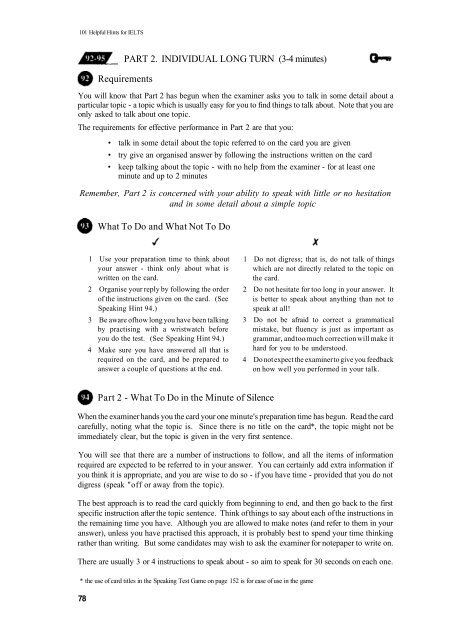Create successful ePaper yourself
Turn your PDF publications into a flip-book with our unique Google optimized e-Paper software.
101 Helpful <strong>Hints</strong> <strong>for</strong> <strong>IELTS</strong><br />
PART 2. INDIVIDUAL LONG TURN (3-4 minutes)<br />
Requirements<br />
You will know that Part 2 has begun when the examiner asks you to talk in some detail about a<br />
particular topic - a topic which is usually easy <strong>for</strong> you to find things to talk about. Note that you are<br />
only asked to talk about one topic.<br />
The requirements <strong>for</strong> effective per<strong>for</strong>mance in Part 2 are that you:<br />
• talk in some detail about the topic referred to on the card you are given<br />
• try give an organised answer by following the instructions written on the card<br />
• keep talking about the topic - with no help from the examiner - <strong>for</strong> at least one<br />
minute and up to 2 minutes<br />
Remember, Part 2 is concerned with your ability to speak with little or no hesitation<br />
and in some detail about a simple topic<br />
What To Do and What Not To Do<br />
1 Use your preparation time to think about<br />
your answer - think only about what is<br />
written on the card.<br />
2 Organise your reply by following the order<br />
of the instructions given on the card. (See<br />
Speaking Hint 94.)<br />
3 Be aware of how long you have been talking<br />
by practising with a wristwatch be<strong>for</strong>e<br />
you do the test. (See Speaking Hint 94.)<br />
4 Make sure you have answered all that is<br />
required on the card, and be prepared to<br />
answer a couple of questions at the end.<br />
1 Do not digress; that is, do not talk of things<br />
which are not directly related to the topic on<br />
the card.<br />
2 Do not hesitate <strong>for</strong> too long in your answer. It<br />
is better to speak about anything than not to<br />
speak at all!<br />
3 Do not be afraid to correct a grammatical<br />
mistake, but fluency is just as important as<br />
grammar, and too much correction will make it<br />
hard <strong>for</strong> you to be understood.<br />
4 Do not expect the examiner to give you feedback<br />
on how well you per<strong>for</strong>med in your talk.<br />
Part 2 - What To Do in the Minute of Silence<br />
When the examiner hands you the card your one minute's preparation time has begun. Read the card<br />
carefully, noting what the topic is. Since there is no title on the card*, the topic might not be<br />
immediately clear, but the topic is given in the very first sentence.<br />
You will see that there are a number of instructions to follow, and all the items of in<strong>for</strong>mation<br />
required are expected to be referred to in your answer. You can certainly add extra in<strong>for</strong>mation if<br />
you think it is appropriate, and you are wise to do so - if you have time - provided that you do not<br />
digress (speak "off or away from the topic).<br />
The best approach is to read the card quickly from beginning to end, and then go back to the first<br />
specific instruction after the topic sentence. Think of things to say about each of the instructions in<br />
the remaining time you have. Although you are allowed to make notes (and refer to them in your<br />
answer), unless you have practised this approach, it is probably best to spend your time thinking<br />
rather than writing. But some candidates may wish to ask the examiner <strong>for</strong> notepaper to write on.<br />
There are usually 3 or 4 instructions to speak about - so aim to speak <strong>for</strong> 30 seconds on each one.<br />
* the use of card titles in the Speaking Test Game on page 152 is <strong>for</strong> ease of use in the game<br />
78




